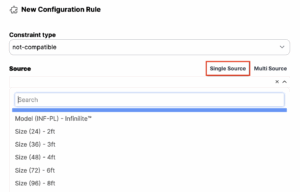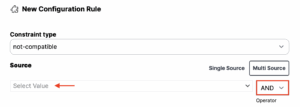![]()
When applying rules within the product configurator, selecting the appropriate source is crucial to ensure accurate product configurations and ordering logic. A source defines the attribute(s) that the rule will evaluate to enforce specific constraints or dependencies.
Types of Sources
Rules can utilize one of the following source types:
- Single-Source
 A single-source rule evaluates a constraint against one specific product code. This is useful when the rule applies to a singular aspect of the product, such as ensuring a certain wattage selection is only available with specific fixture types.
A single-source rule evaluates a constraint against one specific product code. This is useful when the rule applies to a singular aspect of the product, such as ensuring a certain wattage selection is only available with specific fixture types.
Example:- If the fixture aperture is “3 inch” then the available wattage options should only include “15W”.
- Multi-Source

A multi-source rule evaluates constraints against multiple product codes, allowing for more complex relationships between different configuration options. When using multi-source, an additional operator (“AND” or “OR”) must be defined to determine how the attributes relate to each other.- AND Operator: All conditions must be met for the rule to apply.
- OR Operator: At least one condition must be met for the rule to apply.
- Example:
- If the fixture type is “Pendant” AND the color is “Black,” then only “Matte Finish” should be available.
- If the fixture type is “Surface Mount” OR the voltage is “277V,” then “Dimming” is required.
Importance of Selecting the Right Source
Selecting the correct source is vital for applying rule constraints effectively, as it:
- Ensures Accurate Configurations: By identifying the appropriate attributes, the configurator can guide users toward valid product selections and prevent incompatible combinations.
- Improves User Experience: Simplifies the decision-making process by automatically filtering options based on selected attributes.
- Reduces Errors: Minimizes the risk of incorrect product orders by enforcing dependencies between various options.
- Enhances Flexibility: Allows for complex dependencies to be accurately represented using multi-source rules with logical operators.
Best Practices for Identifying Sources
- Determine whether the rule applies to a single attribute or requires evaluation of multiple attributes.
- Use the “AND” operator when all conditions must be satisfied for the constraint to hold.
- Use the “OR” operator when the rule should apply if at least one condition is met.
- Regularly review and validate rules to ensure they behave as expected within the configurator.
By carefully selecting the correct source type and operator, manufacturers can ensure the configurator effectively enforces business logic and delivers an optimal user experience.